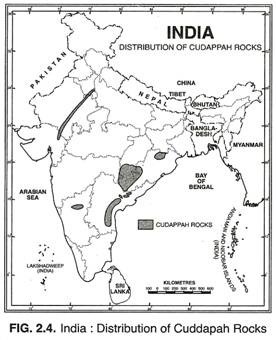Here is your paragraph on the Purana rock system (Proterozoic) of India!
In India, the word purana has been used in place of Proterozoic and includes two divisions the Cuddapah System and the Vindhyas.
The Cuddapah System:
A long interval of time elapsed before the rock system next to the Dharwars and Peninsular gneisses began to be deposited.
A great thickness of unfossiliferous clay, slates, quartzites, sandstones and limestones was deposited presumably in great synclinal basins.
ADVERTISEMENTS:
This formation is known as the Cuddapah system, from the occurrence of the most typical and first-studied, outcrops of these rocks in Cuddapah district of Andhra Pradesh. Naturally the Cuddapah system is separated from the Dharwar system by a great unconformity. In some parts of southern India, we have the Cuddapah system amounting to 6,100 metres in thickness with several unconformities.
The most extensive occurrence of this system is in the Cuddapah district followed by the Kurnool district of Andhra Pradesh. The outcrop is of an irregular crescent shape concave towards the coast covering an area of about 45,000 sq km.
ADVERTISEMENTS:
The crescent shaped outcrops of the Cuddapah rocks suggest that the rocks were subjected to compressive forces directed from the concave side near which stood high mountains that supplied materials forming the rocks of the basin. Another large development of this system is in the southern parts of Chhattisgarh covering the districts of Dantewara, Bastar, Kanker, Dhamtari, Raipur, Durg and Rajnandgaon.
A few isolated exposures occur in Singhbhum district of Jharkhand, Kalahandi and Keonjhar districts of Orissa and along the main axis of the Aravalli range from Delhi to Idar in Gujarat aggregating 5,200 metres in thickness at certain places. Some deposits of Cuddapah rock system are found in Karnataka also (Fig. 2.4).
The economic significance of the Cuddapah system lies in the fact that these rocks contain ores of iron, manganese, copper, cobalt, nickel, barytes, jasper, asbestos, steatite and cherts. They also contain large deposits of building purpose quartzites and cement grade limestones.
The Vindhyan System (1300-600 million years):
This system derives its name from the great Vindhyan mountains although Spate has tried to distinguish between the Vindhyan rocks and the Vindhyan hills. The system comprises of ancient sedimentary rocks superimposed on the Archaean base. It is a vast stratified formation of sandstones, shales and limestones, often over 4000 m thick.
Except a few traces of animal and vegetable life, this group is devoid of any recognisable fossils. Occupying a large area of over 1,00,000 sq km, the Vindhyan system stretches from Sasaram and Rohtas in western Bihar to Chittaurgarh in Rajasthan with the exception of a central tract in Bundelkhand which makes a gap in this belt.
ADVERTISEMENTS:
Large area of this belt is covered by the Deccan trap. The outcrop has the maximum breadth between Agra and Neemuch. These rocks are also found in Chhattisgarh, Bhima Valley of Karnataka and Kurnool district of Andhra Pradesh. The Vindhyan system has been found to continue to the north under the Gangetic alluvium and they are perhaps buckled down underneath the Himalaya.
The rocks of the Vindhyan system comprise two distinct but unequal sets of deposits. The Lower Vindhyan (1,300-1,100 million years) is marine in origin, mostly calcareous in nature and shows tectonic deformation by folding movements. This system is well placed in the Sun Valley, in Chhattisgarh, in the valley of the Bhima and in a separate basin in Mewar.
The upper Vindhayan system (1000 – 600 million years), on the other hand, is fluviatile in origin and is gently lying in undisturbed horizontal strata. The Lower and the Upper Vindhyans are separated by an unconformity which is quite prominent in the north but almost disappears in southern areas of Mewar, Chittaurgarh and the Son valley.
The Upper Vindhayan beds enclose two diamond bearing horizons, from which Panna and Golconda diamonds have been mined. The Vindhyan system, on the whole, is devoid of metalliferous minerals but provides large quantities of excellent and durable free stones, flagstones, ornamental stones, limestone, pure glass making sand and some coal.

